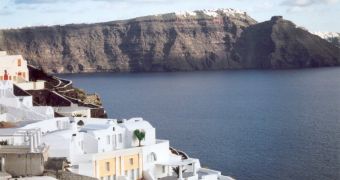Any myth contains a grain of truth. This is also the case of Atlantis, the country swallowed by the sea. The myth of the Atlantis, first mentioned by Plato 2400 years ago, is about a real ancient civilization destroyed by the sea. The Atlantic Ocean got its name from Atlantis, as many subsequent civilizations placed its location in the middle of this ocean. But historical data say this civilization could have been located in the Crete Island or in a nearby island, belonging to the pre-Greek Minoan civilization.
3,500 years ago Minoans developed a complex civilization in the islands of the Eastern Mediterranean, while the rest of Europe was still in the Neolithic ("New Stone Age"), building palaces, paved streets and sewers when Greek tribes lived in shelters. This people was not Indo-European, but rather related to the Basque or Caucasus ethnic groups.
By 1500 BC the civilization of the Minotaur and the Labyrinth suddenly disappeared, being destroyed, it seems, by a giant tsunami. The Minoan civilization was made of seafarers and their towns were located mostly on the coast, exposed to tsunami.
The ancient tsunami could have been as powerful as the 2004 Asian one that killed 250,000 people and was connected to the huge eruption of the volcano of the Santorini island, 70 km (43 mi) north of Crete, up to 10 times more powerful than the Krakatoa's eruption in 1883, volcanic stones even reaching the Egyptian shore of the Sinai peninsula and it was heard at over 3,000 miles (4,800 km) away. The eruption destroyed everything on a distance of 150 km (92 mi).
The Santorini's huge cone fell into the sea together with the western part of the island, provoking a big wave that flooded many islands in the Aegean Sea. The Atlantis, no matter if it was an island or a city (the continent variant is too fictional), could have collapsed due to earthquakes and tsunamis accompanying the eruption.
The stifling volcanic ash impeded for days the sunlight reaching the eastern basin of the Mediterranean. About 80 cubic km of Santorini either blew up or fell into the sea, and all nearby life forms were erased. In time, the island was repopulated and baptized Calliste ("The most beautiful").
Still, the island has erupted 14 times between 198 BC and 1950. The 1659 eruption killed 70 people. The inhabited part of the island was devastated again in 1956 by a massive earthquake. From time to time, the giant volcano spits smoke.
Today, Santorini (also named Thyra) keeps just the eastern half of the ancient volcano. Remains of the ancient Santorini are also the islands of Thirasia and Aspronisi (uninhabited), in the west. The island is like a rock wall volcanic caldera, 300 m (1,000 ft) tall, devoid of sand beaches and harboring two volcanic islets: Nea Kameni and Palaia Kameni. In Antiquity, the island was called Strongyle ("Rounded") because of its shape, before the 3,500 year old eruption.
Excavations made at Santorini in 1966-1967 revealed the presence of a rich royal city, buried in the volcanic debris and kept intact as it was when the eruption occurred. Probably its inhabitants did not want to admit that their splendid city was gone, so the legend of the Atlantis, still flourishing on the bottom of the sea, began.
3,500 years ago, the wave may not have destroyed Knossos, the inland Minoan capital, but the massive ash falls could have ruined the crop, causing famine. At the same date, Egyptians mentioned a huge invasion of the "People of the Sea", seafaring raiders that could have been chased away from the Crete Island by famine. In Canaan they mixed with local Hebrews, forming another civilization of seafarers, the Phoenicians. The Etruscans of Italy could have also rooted in the Atlantis collapse.

 14 DAY TRIAL //
14 DAY TRIAL //